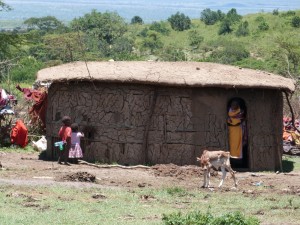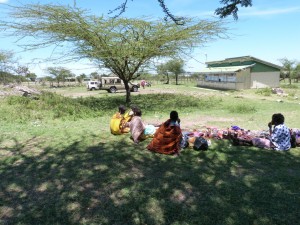































We talk about extending the Internet and IT to everyone on the planet. But some 783 million people -11 percent of the global population -don't even have clean drinking water. About 20 percent have no access to electricity. More people worldwide have mobile phones than toilets. Hunger kills more people every year than AIDS, malaria, and tuberculosis combined.
In that context, connectivity sounds a little frivolous, maybe irrelevant. But is it?
Early this month I visited a remote village at the edge of the Masai Mara National Reserve in Kenya. Sekenani hais some 200 people living in a traditional circle of mud huts. At night 1,000 head of cattle are herded into the commons. There is no electricity and no running water. The people live much the way their ancestors did.
 Traditional Masai home in Sekenani, Masai Mara. The village has no electricity or running water, but the nearby community IT center is giving people new options and opportunities. (One villager even mastered Spanish online at the center.)
Traditional Masai home in Sekenani, Masai Mara. The village has no electricity or running water, but the nearby community IT center is giving people new options and opportunities. (One villager even mastered Spanish online at the center.)Except for the mobile phones tucked into their shukas (the traditional Masai robes); email, Web-surfing, and the Cisco Networking Academy at the local community IT center; and soon-to-be Cisco Health Presence at the local clinic.
Africa has some of the world's least-expensive mobile data, which has encouraged an explosion of innovation. My colleague Robert Pepper blogged recently about a Masai watchman in Nairobi who uses Safaricom's mobile-based money transfer and microfinancing solution. With M-PESA, this breadwinner can pay bills and send his paychecks home to the family using his mobile phone. Another Safaricom app, M-KOPA, provides a loan for a small solar equipment set-up for the home, allows the purchaser to pay using M-PESA, and even keeps track of the amount of electricity generated. Yet another application developed in Kenya tracks cattle using RFID chips -which helps meet the requirements of the European Union, and so opens that market up to African herders.
Three years ago I had the honor of helping cut the ribbon at Sekenani Community Knowledge Center. The area's first community IT center is a modest, concrete-block building near the village. Cisco provided the content, training, and equipment (powered by solar cells on the tin roof) through the Clinton Global Initiative. Connectivity is provided by Orange, a subsidiary of France Telecom, using a low-cost, long distance WiFi solution. Long-range outdoor WiFi equipment mounted on an Orange tower delivers the "last mile" of connectivity to the center.
 Masai women near the Sekenani Community Knowledge Center, Masai Mara. Cisco helped establish the computer learning center and Cisco Networking Academy in 2010.
Masai women near the Sekenani Community Knowledge Center, Masai Mara. Cisco helped establish the computer learning center and Cisco Networking Academy in 2010.This year, I took part in a great Cisco Connect Kenya in Nairobi (aka Africa's "Silicon Savannah," thanks to the burgeoning IT invention and innovation there). Then I went back to Sekenani to see if our hopes from 2010 had been realized. I was gratified to learn that being connected has been a big boon to education and that Sekenani has a flourishing Cisco Networking Academy. Even better, the benefits have rippled out into the community at-large.
Geoffrey Tira, the treasurer of the adjacent Sekanani Community Health Centre, gave me an example. A villager might need a copy of a routine government form. The copy might only cost five shillings, but before the computer center existed the only way to get it would have been to travel 110 kilometers to Narok, the nearest town -turning a five shilling expense into a half-day junket that costs about 4,000 shillings.
Another example: James Ole Lesaloi is a local entrepreneur and the founder of Semadep Camp. (Semadep is the Sekenani Maasai Development Project, which focuses on projects to benefit the Masai.) James used to have to spend a couple of days a week in Narok just to coordinate with prospective visitors to his safari camp. Today he walks to the community IT center and can respond to inquiries within minutes or hours instead of days.
Connectivity is about to transform the local healthcare scene as well. Sekenani Community Health Centre is a stone's throw from the computer center. Established in 2007, it serves people from around the area. It's powered by solar, too, by the way. Sometimes they have to stop the centrifuge until the batteries can recharge. When babies are born at night, nurse-midwife Rose Koriata frequently has to grip a flashlight with her teeth and just get to work.
 Masai woman arriving at Sekenani Community Health Centre.
Masai woman arriving at Sekenani Community Health Centre.Two months from now, thanks to more solar panels, connectivity from Orange, and Cisco's Health Presence solution, Sekenani will be connected directly to medical expertise in Nairobi and beyond. That means someone with issues beyond the scope of the local clinic may not have to travel five hours by road or an hour by air for diagnosis, treatment, and follow-up.
 In-charge Samuel N. Kamicha briefs Howard in his office, where Cisco Health Presence will be installed by the end of 2013. (L to R: James Ole Lesaloi, Musa Langat of the Sekenani Community Knowledge Center, Samuel Kamicha, Howard Charney, Geoffrey Tira)
In-charge Samuel N. Kamicha briefs Howard in his office, where Cisco Health Presence will be installed by the end of 2013. (L to R: James Ole Lesaloi, Musa Langat of the Sekenani Community Knowledge Center, Samuel Kamicha, Howard Charney, Geoffrey Tira)About 40 years ago, my former colleague Bob Metcalfe came up with a formula to express the exponential value of additional connections to the network. The fax machine was the classic illustration of Metcalfe's Law. One fax is worthless, but as each additional one is added the value of every other fax machine goes up exponentially.
Back then, no one could have imagined that today we'd need to factor in an explosion of sensor network technologies on the low end (such as the RFID app that tracks cows) and very high-bandwidth, real-time video solutions such as Cisco Health Presence.
What I think we are beginning to see, even in very remote places such as the Masai Mara, is exponential value on steroids. The Internet of Everything is not going to leave the Masai behind. To the contrary.
Before I left the computer center, I was introduced to a game warden who was studying networking. I asked him which path he would choose, when he was finished... being a game warden or networking? He looked puzzled at the either-or question. "I will do both," he said.
That was the right answer. That is the multiplier at work.
 Howard delivers a new broadband router to Cisco Networking Academy instructor Kerri Robinson. (L to R: Geoffrey Tira, Kerri Robinson, James Ole Lesaloi, Howard Charney)
Howard delivers a new broadband router to Cisco Networking Academy instructor Kerri Robinson. (L to R: Geoffrey Tira, Kerri Robinson, James Ole Lesaloi, Howard Charney)Editor's note: Howard Charney co-founded 3Com with Bob Metcalfe. 3Com invented Ethernet. Later, Howard founded Grand Junction Networks, which developed Fast Ethernet and low-cost switching. Ethernet, Fast Ethernet and low-cost switching have been key to the global build-out of the Internet.
 Hot Tags :
Hot Tags :